Related Research Articles

The Canary Islands, also known informally as the Canaries, are a Spanish autonomous community and archipelago in Macaronesia in the Atlantic Ocean. At their closest point to the African mainland, they are 100 kilometres west of Morocco and the Western Sahara. They are the southernmost of the autonomous communities of Spain. The islands have a population of 2.2 million people and are the most populous special territory of the European Union.
Santa Cruz or Santacruz may refer to:
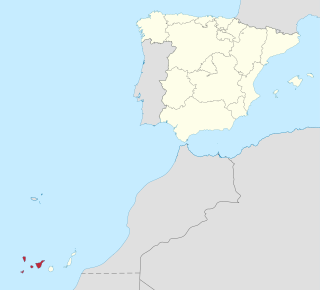
Province of Santa Cruz de Tenerife, also Province of Santa Cruz, is a province of Spain, consisting of the western part of the autonomous community of the Canary Islands. It consists of about half of the Atlantic archipelago: the islands of Tenerife, La Gomera, El Hierro, and La Palma. It occupies an area of 3,381 km2 (1,305 sq mi). It also includes a series of adjacent roques.
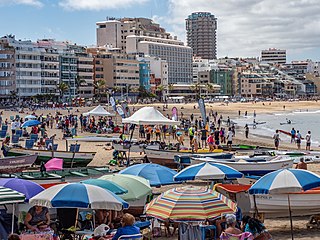
Las Palmas, officially Las Palmas de Gran Canaria, is a Spanish city and capital of Gran Canaria, in the Canary Islands, in the Atlantic Ocean.

Rail transport in Spain operates on four rail gauges and services are operated by a variety of private and public operators. The total route length in 2012 was 16,026 km.

Gran Canaria, also Grand Canary Island, is the third-largest and second-most-populous island of the Canary Islands, an archipelago off the Atlantic coast of Northwest Africa and is part of Spain. As of 2023 the island had a population of 862,893 that constitutes approximately 40% of the population of the archipelago. Las Palmas de Gran Canaria, the capital of the island, is the biggest city of the Canary Islands and the ninth of Spain.

Tenerife is the largest and most populous island of the Canary Islands. It is home to 42.9% of the total population of the archipelago. With a land area of 2,034.38 square kilometres (785.48 sq mi) and a population of 948,815 inhabitants as of January 2023, it is also the most populous island of Spain and of Macaronesia.

Santa Cruz de Tenerife, commonly abbreviated as Santa Cruz, is a city, the capital of the island of Tenerife, Province of Santa Cruz de Tenerife, and one of the capitals of the Canary Islands, along with Las Palmas. Santa Cruz has a population of 206,593 (2013) within its administrative limits. The urban zone of Santa Cruz extends beyond the city limits with a population of 507,306 and 538,000 within urban area. It is the second largest city in the Canary Islands and the main city on the island of Tenerife, with nearly half of the island's population living in or around it.
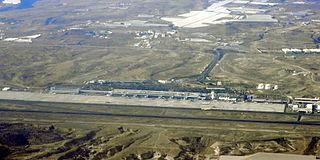
Tenerife South Airport, also known as Tenerife South–Reina Sofía Airport, is the larger of the two international airports located on the island of Tenerife and the second busiest in the Canary Islands.

The TF-1 is a motorway encircling the eastern and the southern parts of the island of Tenerife. The TF-1 motorway runs from the capital Santa Cruz in the north to Adeje with its major tourist resorts Los Cristianos and Playa de las Américas in the south of the island, and continues to Santiago del Teide in the west. It is a 103 km motorway and interchange numbers go facing south. The motorway is one in the Canary Islands that passes through most of the municipalities and is the longest in the archipelago as well.

Tenerife Tram is a light rail or tram service located on the island of Tenerife, one of the Canary Islands in Spain. It is operated by Metropolitano de Tenerife, a limited company now 100% owned by Cabildo de Tenerife. Service started on 2 June 2007 over a 12.5-kilometre (7.8 mi) route that linked the Intercambiador in Santa Cruz de Tenerife with Avenida de la Trinidad in La Laguna. A second line between La Cuesta and Tíncer opened in 2009. It is the only existing tramway or train in the Canary Islands.
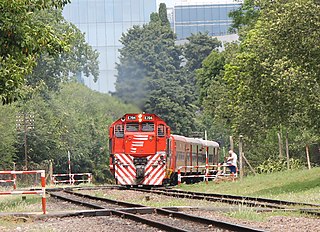
The Belgrano Norte line is a commuter rail service in Buenos Aires, Argentina run by the private company Ferrovías since 1 April 1994. This service had previously been run by the state-owned General Belgrano Railway since nationalisation of the railways in 1948. Ferrovías also formed part of the consortium Unidad de Gestión Operativa Ferroviaria de Emergencia (UGOFE) which operated other commuter rail services in Buenos Aires.
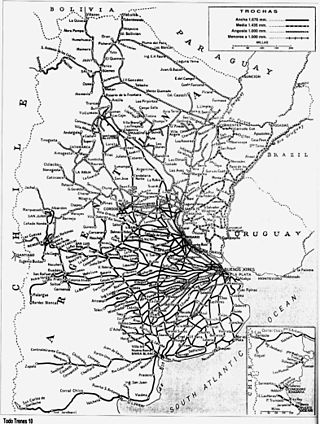
The Argentine railway network consisted of a 47,000 km (29,204 mi) network at the end of the Second World War and was, in its time, one of the most extensive and prosperous in the world. However, with the increase in highway construction, there followed a sharp decline in railway profitability, leading to the break-up in 1993 of Ferrocarriles Argentinos (FA), the state railroad corporation. During the period following privatisation, private and provincial railway companies were created and resurrected some of the major passenger routes that FA once operated.

The Ferrocarriles del Ecuador Empresa Pública is the national railway of Ecuador. The railway system was devised to connect the Pacific coast with the Andean highlands. After many decades of service the railway was severely damaged by heavy rainfall during the El Niño in 1997 and 1998 and from general neglect as the Pan-American Highway siphoned off passengers.

The history of rail transport in Chile has gone through several periods of boom and bust. It began in 1840, with the construction by William Wheelwright of the first branch in the north. Further construction proceeded apace linking cities from Pisagua all the way to Puerto Montt.

The Buenos Aires Metrobús is a 50.5 km (31.4 mi) network of dedicated separated lanes and stations for buses that serve the city of Buenos Aires, Argentina. Designed as a Bus Rapid Transit system, it mixes a few bi-articulated buses with conventional buses. The headway is the same as before the implementation of the system, and the buses on the system use the same brand as the main network, that is, maintaining their previous branding as common bus lines with their own numbers. The service operates 24 hours a day and 365 days a year, with 2-4 minute frequencies during the day and 10–15 minutes at night.

The Puerto Deseado and Colonia Las Heras Railway was a State-owned railway company that ran between the cities of Puerto Deseado to Colonia Las Heras in Santa Cruz Province. The 283-km broad gauge railway was established with the intention of encouraging settlement in Patagonia, which was sparsely populated at that point. The railway also contributed to the commercialisation of wool in the region.

Tren de Gran Canaria is a proposed railway on the island of Gran Canaria in the Canary Islands. It is planned to run from the island's capital, Las Palmas along the eastern coast of the island, serving Gran Canaria Airport and terminating in Maspalomas. First announced in 2004, construction on the line has not yet commenced due to funding difficulties.

Tranvía Villasegura was a tramway that ran between Santa Cruz and La Laguna in Tenerife, Canary Islands. Opened in 1901, it extended to Tacoronte in 1905, and closed in 1956. A new tram system, Tranvía Tenerife, started operation along a similar route in 2007.
In the run up to the 2023 Spanish local elections, various organisations carry out opinion polling to gauge voting intention in local entities in Spain. Results of such polls for municipalities and island cabildos in the Canary Islands are displayed in this article. The date range for these opinion polls is from the previous local elections, held on 26 May 2019, to the day the next elections will be held, on 28 May 2023.
References
- 1 2 "Memoria del Tren del Sur" (PDF). Archived from the original (PDF) on 7 January 2024. Retrieved 10 April 2010.
- 1 2 "Datos técnicos del Tren del Sur" . Retrieved 10 April 2010.
- 1 2 "El Tren del Sur de Tenerife estará operativo en ocho años y generals más de mil empleos" . Retrieved 10 April 2010.
- ↑ "El Cabildo suspende los proyectos constructivos del tren del sur de Tenerife" . Retrieved 9 June 2012.
- ↑ "Tenerife to restart planning for Tren del Sur" . Retrieved 13 July 2017.
- ↑ "Tren del Norte" . Retrieved 10 April 2010.